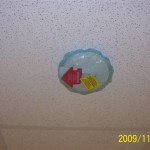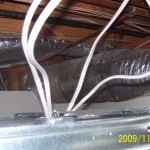According to my city inspector, I should install a fire alarm in each room in my remodeled basement. All the fire alarms should interconnected. This was for the safety of the occupant so when one of the alarms detected fire, all the alarms in the system would beep. Since I already had a home security system in rest of the house. I just needed four more fire alarms. I looked at my exiting fire alarms but I did not see any brand or model number. All I saw was warning. I thought it was odd.
After checking in my local Homedepot on available models and a careful research on Amazon.com, I decided on Kidde I12060 hardwire with front load battery backup smoke alarms. This model was rated 4.5 stars in Amazon. I liked it because I could wire up to 24 alarms. With battery backup, they would protect my family even when the the AC power was down. According to reviews in Amazon, they did not generate false alarm. The HomeDepot price of less than $16.00 also help. Its online manual stated that the alarm would network with FireX and other brands. I thought I should be OK to install them in my basement.
I purchased 4 of them. After I checked with the HomeDepot staff, I purchased 100 ft of 14-3 Romex SIMpull NM-B 100 FT Building Wire. The alarm used 2 wires for the AC power (Black for Line, White for neutral) and Red for Signal. I also bought 4 junction boxes for drop ceiling and 4 drop ceiling extension connectors.
First, I cut holes in the center of drop ceiling tiles with a Long Wallboard Saw so the junction box could fit through. The wall board saw made the job a little easier than the standard utility knife. Then I mounted the junction box to the drop ceiling extension connectors, but did not tighten the mounting screws. I put the ceiling tiles into the drop ceiling grid. Moved the drop ceiling extension connectors to make sure that the connectors sat on the ceiling grid well. Drilled screw holes on the grid to fix the extension connectors to the grid. Tightened the junction box mounting screws at the end.
I pulled the cables to all the locations. However, before I mount and wired all the alarm, I tested one of them to see if it was compatible with the system I had. When I took the cover of my existing alarm off, I was surprised to see that it was FireX brand model G-6 with yellow signal wire. I suspected my new fire alarms would not work with the existing system. I connected the black wire to AC line (Black to Black), white wire to AC neutral (white to white) and Kidde red signal wire to FireX yellow wire. As soon as I applied power, the Kidde alarm started to beep. My worse fear come true – these two models were not compatible even they were both from Kidde! Well, not much I could do, I went back to HomeDepot to purchase 4 FireX fire alarms. Now the wiring was much easier, yellow to yellow. All the alarms were parallel to each other. After I wired them up and applied power, one of the alarm started to beep. I checked the wires, its neutral wire was loose. After I re-wirenuted the neutral wire, it stopped beeping. All four fire alarms’ LED light turned to green. I pushed and held the test button on one of them, after 5 seconds, all the alarms beeped – new ones and existing ones. I was happy to see that it worked. Then I put the dust covers back on the fire alarms so they would not get dirty from the construction.
It took me about 5 hours and 5 trips to HomeDepot to get this project done. If you need to install interconnected fire alarms, be sure that you take the cover off the existing fire alarms to check its brand and model (I just do not understand why the manufacturer did not print the brand and model on the outside). You should have #12 – 4 wire nuts or even #12-5 wire nuts and 12-3 quickpull cable. This should save some trips to the hardware stores.

